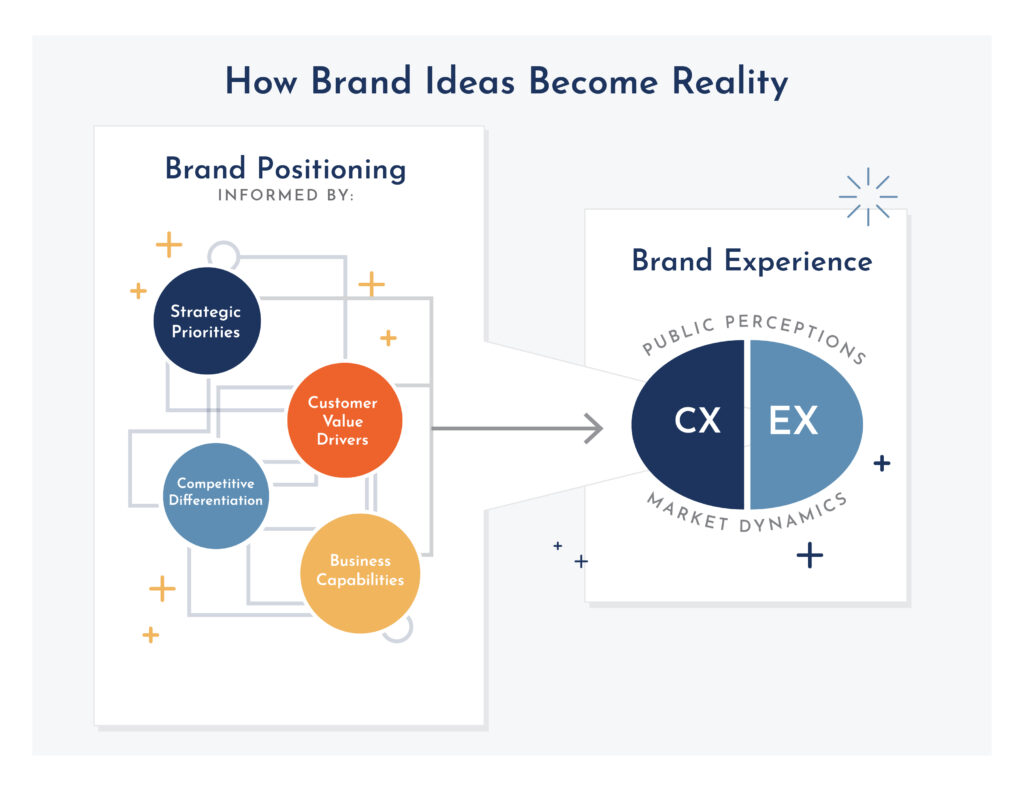Your brand is not your company logo. It’s not your product or service, either. It isn’t the fonts you use, the advertisements you produce, or the widgets on your website.
Your brand is the feeling your employees get when they go to work. It’s the “emotional aftertaste” your customers have after they fill an order, make a purchase, or resolve an issue. Your brand is a promise that reinforces the value and experience employees and customers can expect every time they interact with your business.
Simply put, it’s who people think you are and how you make them feel.
Curating this feeling is a delicate balancing act involving multiple factors. Some factors, such as your customer and employee experience strategy, are well within your company’s control. Other elements, including market dynamics and the public’s perception of your organization, aren’t necessarily dictated by a strategic campaign or experience program—and yet they’re just as important in determining how your brand strategy “shows up.” These combined factors—your customer experience (CX), employee experience (EX), market dynamics, and public perceptions of your organization—are the essence of your brand experience, or BX.
For all the visual learners out there, we’ve illustrated how an enterprise’s intended brand positioning is reflected in its CX, EX, and across the marketplace:

If there’s a gap between how your company sees itself and how others see it, the foundation of your BX will inevitably crumble. Misalignment can manifest in a number of ways, but employees are often the first ones to see cracks in the facade. Many times, brand (or rebrand) strategy is set at too high an altitude with few allowances or considerations for the reality on the ground, leaving employees feeling disconnected from a brand promise that just doesn’t ring true. This causes an all-too-familiar domino effect: employees failing to act in a way that’s consistent with the stated brand promise (intentionally or unintentionally), which generally leads to a drop in employee engagement that, if left unchecked, ultimately leads to attrition. A vicious cycle has begun.
The next series of dominos to fall are around the CX. When the BX doesn’t resonate with employees—the bearers of brand messaging and deliverers of value—customers feel it, too. And if the rebrand has failed to account for the needed business capabilities necessary to deliver on your (new) brand promise, that exacerbates the poor CX. In the end, you’re left telling a story that’s not reflective of the true employee or customer experience, and with a brand promise that doesn’t deliver to either audience.
The Risk and Rewards of Rebranding
The importance of curating an authentic brand isn’t lost on most companies, 75% of which have pursued a rebrand since 2020. Despite a heightened focus on brand repositioning, these efforts frequently fail—either to produce intended outcomes or outright—and the problem is threefold:
1. Companies view rebranding strictly as a creative/visual identity exercise that doesn’t reach beyond marketing,
2. They acknowledge the strategic component, but don’t account for the operating model changes that are required to bring the brand promise to life, or
3. They aren’t positioning brand value in a way that resonates with customers (and employees)
To recast your brand and inspire both customer loyalty and employee engagement, your brand experience must be curated and enabled across the fabric of your entire organization and into the marketplace. This creates a complex yet tightly woven tapestry in which all brand experiences and touchpoints tie to and strengthen the greater enterprise strategy.
If this sounds like a massive undertaking, it is—especially for large organizations with layered hierarchies and dozens of business units. Getting everyone to sing from the same songbook is hard, and it requires diligent orchestration and collaboration. But when the brand, customer, and employee experience are finally in sync with each other, and ultimately, with your business strategy, it creates brand consistency which leads to competitive differentiation in the marketplace and increased shareholder value. A recent study by Jonathan Knowles at Type 2 Consulting found that brand value comprises more than 20% of the market capitalization of most industries, ranging up to 40% for companies in the consumer services sector. That’s real financial impact.
Redefining the Rebrand: Where to Start
While there’s no universal “step one” when it comes to facilitating a successful rebrand, focus on the following:
1. Ground your brand positioning in your enterprise strategy and how your customers define value. Competitive differentiation is important, but if you can’t deliver on your brand promise—or you’re promising something customers don’t want—you won’t find the ROI you seek.
2. Don’t silo (re)brands in marketing. These are strategic initiatives, and they deserve to be treated as such. HR and your CX team need to be involved to ensure the customer and employee experiences play a starring role in how your brand is going to show up, internally and externally.
3. Define the business case. Many rebrands turn into boondoggles because the hard cost of rebranding is not well-understood up front, and the ROI on brand messaging is treated as an intangible. Don’t fall into this trap. Like any business initiative, hard and soft costs should be estimated up front along with success criteria and an associated measurement plan. There are plenty of ways to measure brand ROI that don’t require fuzzy math.
4. Don’t go it alone. Similar to looking at yourself in a mirror, it’s hard to be objective when it comes to internal and external perceptions about your organization. Find a (preferably external) “truth teller” who can take an objective look at your organization and identify opportunities to drive better consistency between your desired brand positioning and how you show up to customers, employees, and other key stakeholders.
5. Think long term. It’s tempting for executives to fall into the trap of focusing on short-term marketing campaigns to drive sales activation vs. long-term brand building, especially as marketing cycles grow shorter with the rise of digital and real-time analytics. However, research has shown that short-termism, while improving immediate return on marketing investment (ROMI), is actually detrimental to bottom line profitability, and ultimately leads to a decline in brand value.
When in doubt, look to companies that have a well-positioned brand and analyze their approach. How do these entities invest in their brand, internally and externally, to build trust and emotional connection among customers and employees alike? What core business capabilities do they bring to the table (front-, middle-, and back office) to ensure they keep their brand promises? What metrics do they track to ensure they are in fact, who they say they are?
Resolving the BX-EX-CX alignment gap isn’t an overnight fix. Your brand strategy must be ingrained in the way your organization operates, including how it serves customers, engages employees, and translates your internal brand to an external audience. This process takes time, careful coordination, and a long-term view. But like any long journey, it can begin with a few small steps—and the final destination is worth it.
To learn more about how Navigate can help you unify your brand, employee, and customer experience, drop us a line.

